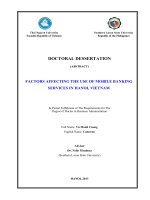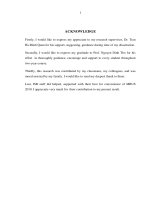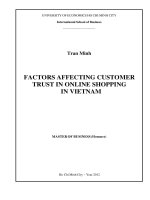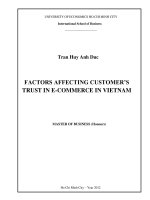Factors affecting customer loyalty in mobile communication services in ha noi, viet nam
Bạn đang xem bản rút gọn của tài liệu. Xem và tải ngay bản đầy đủ của tài liệu tại đây (1.26 MB, 204 trang )
FACTORS AFFECTING CUSTOMER LOYALTY IN MOBILE
COMMUNICATION SERVICES IN HANOI, VIETNAM
___________________________
A DISSERTATION
Presented to the Faculty of the Graduate School
Southern Luzon State University, Lucban, Quezon, Philippines
in Collaboration with
Thai Nguyen University, Socialist Republic of Vietnam
___________________________
In Partial Fulfillment
of the Requirements for the Degree
Doctor of Business Administration
___________________________
By
NGO ANH CUONG (SMILE)
December 2013
i
APPROVAL SHEET
The Dissertation of
NGO ANH CUONG
entitled
FACTORS AFFECTING CUSTOMER LOYALTY IN MOBILE
COMMUNICATION SERVICES IN HANOI, VIETNAM
Submitted in Partial Fulfilment of the Requirements for the Degree
DOCTOR OF BUSINESS ADMINISTRATION
A program offered by Southern Luzon State University,
Republic of the Philippines in collaboration with
Thai Nguyen University, Socialist Republic of Vietnam
has been approved by Oral Examination Committee
MELCHOR MELO O. PLACINO, PhD
Expert
CONRADO L. ABRAHAM, PhD
Expert
JOANNA PAULA A. ELLAGA, DBA
Expert
EDWIN P. BERNAL, DBA
External Panel
CECILIA N. GASCON, PhD
Chairman
Endorsed by:
Recommended by:
NELLY I. MENDOZA, DBA
Adviser
APOLONIA A. ESPINOSA, PhD
Dean
Accepted in Partial Fulfilment of the Requirements for the Degree
Doctor of Business Administration
_____________________
Date
WALBERTO A. MACARAAN, EdD
Vice President for Academic Affairs
ii
CERTIFICATE OF ORIGINALITY
This is to certify that the research work / dissertation entitled “Factors
affecting customer loyalty in mobile communication services in Hanoi,
Vietnam”, orally defended/ presented under the DBA Program jointly offered
by Southern Luzon State University of the Republic of the Philippines and
Thai Nguyen University of the Socialist Republic of Vietnam, embodies the
result of original and scholarly work carried out by the undersigned.
This dissertation does not contain words or ideas taken from published
sources or written works by other persons which have been accepted as basis
for the award of any degree from other higher education institutions, except
where proper referencing and acknowledgement were made.
Researcher/Candidate:Ngo AnhCuong (Smile)
Date Orally Defended:
October 10, 2013
iii
ACKNOWLEDGMENT
Iwould liketo express ourmost sincere thankstothe Management Board
ofthe SouthernLuzonState University, Thai Nguyen University; teachers of
theschoolhavehelped mefacilitatethe learning processthroughout.
Iwould
like
to
myenthusiasticteacher
expresssinceregratitude
to
Dr.
whohasdedicatedguidance,
Nelly Mendoza,
encouragement,
timeandhas shared knowledgefor meduringthis research. I also would like to
thank Dr Joanna Paula Ellaga who has insightful suggestion for my
dissertation.
IsincerelythanktheBoard
of
theUniversityofLaborandSocial
Affair
(ULSA), colleaguesinULSA, classmates in DBA1 who enthusiastically
facilitated,helped andsharedexperienceto helpcomplete the dissertation.
Finally, Iwould like to thank my best friends who have encouraged to
complete mydissertation.
Ngo AnhCuong
iv
DEDICATION
To My Family
and Friends
this piece of work
is for you…
NAC
v
TABLE OF CONTENTS
PAGE
TITLE PAGE ………………………………………………………………..
i
APPROVAL SHEET ……………………………………………………….
ii
CERTIFICATE OF ORIGINALITY ………………………………………..
iii
ACKNOWLEDGEMENT …………………………………………………..
iv
DEDICATION ………………………………………………………………
v
TABLE OF CONTENTS …………………………………………………..
vi
LIST OF TABLES ………………………………………………………….
viii
LIST OF FIGURES ………………………………………………………...
x
ABBREVIATIONS ………………………………………………………….
xi
LIST OF APPENDICES …………………………………………………...
xii
ABSTRACT …………………………………………………………………
xiii
CHAPTER
I
II
III
INTRODUCTION ……………………………………………
1
Background of the Study …………………………………..
2
Statement of the Problem ………………………………….
3
Objectives of the Study …………………………………….
4
Hypotheses of the Study ……………………..……………
5
Significance of the Study …………………………………..
6
Scope and Limitations of the Study ………………………
7
Definition of Terms ………………………………………….
8
REVIEW OF LITERATURE ……………………………….
11
Conceptual Framework ………………………………….…
39
METHODOLOGY
Locale of the Study …………………………………………
41
Research Design ……………………………………………
41
Determination of Sample Size …………………………….
43
Sampling Design and Techniques ………………………..
43
Research Instrument ……………………………………….
44
vi
IV
V
Data Gathering Procedure …………………………………
51
Data Processing Method ……….………………………….
51
Statistical Treatment ………………………........…….……
51
RESULTS AND DISCUSSIONS ………………………….
54
4.1 Respondent’s Profile …………………………………..
54
4.2 Preliminary Analysis of the Component Variables ….
56
4.3 Hypothesis Test ………………………………………...
60
4.4 Factors Affecting Customer Loyalty ………………….
66
SUMMARY, CONCLUSION AND RECOMMENDATION
Summary…………….………………………………………
86
Conclusions …………………………………………………
89
Recommendations …………………………………………
91
REFERENCES ………………………...…………………………………..
98
APPENDICES ……………………………………………………………...
101
CURRICULUM VITAE …………………………………………………….
189
vii
LIST OF TABLES
TABLE
3.1
PAGE
Factors
Affecting
Customer
Communication Services
Loyalty
in
Mobile
42
3.2
The Distributive Sample by Service Provider
44
3.3
Cronbach Alpha of Component Services Quality
46
3.4
Cronbach’s Alpha of the Component Switching Barriers
50
4.1
The Distributive Sample by the Gender and Age
54
4.2
The Distributive Sample by the Gender and the Market
Share
55
The Distributive Sample by Services Type and the Market
Share of Service Providers
55
The Summary of the Distributive Sample by Gender, Age
and Type of Service Providers
56
4.5
How to Calculate the Average Value of the Variable
57
4.6
The Mean Value of Service Quality
59
4.7
The Mean Value of Switching Barrier
60
4.8
Correlation Coefficients of Variables
63
4.9
Correlation Coefficients of Switching Barrier and Customer
Loyalty Variables
66
4.10
Relationship Between Gender with Service Providers
67
4.11
Relationship Between Education of Subscribers with
Selection Service Providers
69
Relationship Between Selections of Service Provider with
Occupation of the Subscribers
70
Relationship Between Selection of Service Provider With
Per Average Income of Subscribers
71
Relationship between Value - Add Service with Gender of
Subscribers
72
Relationship between “Adapting Cost” with Gender of
Subscribers
73
4.3
4.4
4.12
4.13
4.14
4.15
viii
TABLE
4.16
4.17
4.18
4.19
PAGE
Relationship Between Calling Quality of Service Providers
with Per Average Income of Subscribers
76
Relationship Between the Adapting Cost with Subscriber’s
Ages
77
Relationship Between Assessment About “The Supplier
Has Service Packages With Different Charge to Suitable
Customer Demands” With Education Level of Subscribers
79
Model Summary
81
ix
LIST OF FIGURES
FIGURE
1
PAGE
The Market Share of Mobile Subscribers in Hanoi, 2011
and 2012
15
2
Proposed Integrated Model of Service Loyalty
31
3
Switching Barrier Model of Customer Loyalty
32
4
Customer Loyalty about Mobile Communication Service in
American
36
The Model of Impacting Satisfaction and Switching Barrier
to Customer Loyalty the Mobile Communication Service in
Korea
37
The Proposed Model for Mobile Communication Service in
Hanoi
40
5
6
x
ABBREVIATIONS
VNPT
Viet Nam Post and Telecommunications Corporation
VINAPHONE Viet Nam Telecom Services Company
VMS
Viet Nam Mobile Telecom Services Company (Mobifone)
VIETTEL
Viettel Telecom Company
SPT
Saigon Post & Telecommunications (Sfone)
GTEL
GTel Mobile JSC (Gmobile)
HANOI TELECOM Ha Noi telecom Corporation (Vietnammobile)
xi
LIST OF APPENDICES
APPENDIX
PAGE
1
Questionnaire
102
2
Descriptive Statistics
105
3
Relationship Between Factors Affecting Loyalty Versus
Demographic Factors
106
Results of Regression and Correlation
186
4
`
xii
ABSTRACT
Title of Research
: FACTORS AFFECTING CUSTOMER LOYALTY IN
MOBILE COMMUNICATION SERVICES IN
HANOI, VIETNAM
Researcher
: NGO ANH CUONG (SMILE)
Degree Conferred
: DOCTOR OF BUSINESS ADMINISTRATION
Name and Address
of Institution
: Southern Luzon State University Lucban, Quezon,
Philippines and Thai Nguyen University, Socialist
Republic of Vietnam
Adviser
: Dr. Nelly I. Mendoza
Year Written
: 2013
______________________________________________________________
Customer turns to be an important concern for management due to the
increasing competition particularly in mobile telecommunication services.
Customer loyalty plays a very crucial role for achieving the competitive
advantage for enterprises. According to service providers, service quality calling quality, pricing structure, value – added service, customer support
services, etc, and switching barriers -loss cost, adapting cost, attractiveness
of other service providers, etc, are motivational factors to maintain customer
loyalty as well as an essential element for business and increasing market
share.
Currently, Hanoi is one of the cities in Vietnam that has a great number
of
mobile
subscribers
and
suppliers.
According
to
theMinistry
of
Informationand Communication, in 2012, there were 9.1 millionmobile
subscribers in Hanoi in which, market share of the service provider are as
follow:Vinaphone was 31.25%, Viettel was 43.03%, Mobifone was 18.5%,
Vietnammobilewas 2.57%, Gtel was 4.63% and SPT was 0.02%. Thus, the
xiii
study would like to identify the factors that primarily affect the loyalty of the
mobile subscribers to mobile communication services in Hanoi, Vietnam.
The main tool is a questionnaire used to gather information on
customer loyalty for mobile service providers in Hanoi. Since the researcher
did not have the list of the customers of service providers, the sampling
method used was random sample based on several factors: the market share
of vendors, demographic (gender, age group and occupation) factors, and
types of services (postpaid and pre-paid). There were 400 customers who
were selected for the interview. In addition to information about the
customers, the questionnaire was designed to include 42 attributes of mobile
communication services that customers usually look for rated through the
Likert scale having the descriptive rating from 5 for strongly agree to 1 for
strongly disagree. The subscribers, as the respondent were interviewed
irrespective if they are prepaid and postpaid customers.
The study used correlation coefficients and Chi-square test to test the
hypothesis and assess the relationship between factors with customer loyalty.
The multiple regression model was used to evaluate the factors affecting
customer loyalty in the mobile communications market in Hanoi.
Results of analyzing demographic factors (occupation, per everage
income, subject payment, service providers and using time) showed that there
are relationship between these factors with customer loyalty.
Result of analyzing multiple regression model showed that there were 7
factors affecting customer loyalty. The “service quality” had four components:
calling quality, pricing structure, value-added services and convenience in
procedures. The “switching barrier” had three components: loss cost,
xiv
attractiveness of other suppliers and customer relationship. In these factors
that affect customer loyalty, the "customer relationship" was the strongest
influence. Therefore, service providers should improve the "customer
relationship" to maintain existing customers and attract new customers.
xv
1
Chapter 1
INTRODUCTION
Customers are invaluable assets of the business. Customer loyalty is
significant to the future development of a general company or the particular
mobile service providers. It contributes to maintain stable profits when the
subscriber reaches the saturation point, mature market and fierce competition.
According to the Nguyen Duc Ky and Bui Nguyen Hung (2007), the
developmental history of the mobile communication services market in
European countries, the United States and some countries in the region such
as China, Korea, Taiwan, India, etc, and even in Vietnam showed that the
general market has some notable features. When the market is new and its
rapid growth is through technological innovation, the technological cycle is
more and more shorter. Initially, the mobile services was the monopolist
market (monopoly technology, monopoly of scale…) and it only provided
services for postpaid so customers was tied by service contract of the
provider.
After the market was opened, technology becomes popular,
investment costs decline, new providers enter the market, competitive pricing
becomes a practice, value- adding to improve service quality is included as a
strategy and customers have many opportunities to select providers.
Thus, in recent years it was realized that researches have to be done on
the different models about satisfaction and customer loyalty in the mobile
communication services. These researches were built on the ground of the
traditional relationship between service quality and satisfaction-loyalty and
analyzing factors affecting customer behavior. In addition, researches in
2
Korea, China, Taiwan have showed that the mobile communication markets in
these countries have many similarities with the market in Vietnam.
In Vietnam, the mobile communication market has been transforming
from a monopolistic market to competitive market with participation of more
and more service providers. Therefore, customers have many opportunities to
choose services less bound to the service provider. The change of service
providers by customers becomes phenomenal and increasing.
To develop positively and sustainably for Vietnam’s mobile market,
service providers need to find ways to maintain valuable and loyal customer.
Background of the Study
According to the suppliers of telecommunications services, service
quality, with wide network coverage, network capacity and customer care are
the key driving force to maintain customer loyalty. However, survey results of
the Strategy Analytics with 215 suppliers who have been representing 75% of
mobile subscriber worldwide poses a challenge in developing strategies to
retain customers. Whereby in 2011, there are 44% of global mobile
subscribers to change service providers, the highest ever, with an average
churn time is 27/1. Compared with a decade ago, the time for loyal
subscribers with the service provider has halved (www.vnpt.com.vn/new)
So, research on factors affecting customer loyalty in mobile
telecommunication services in Viet Nam is significant to discover new scale
and a new theoretical model for managers. In practice, they "retain"
customers, as customers become more loyal then it brings the urgency
especially to the three big service providers: Vinaphone, Mobiphone, and
Viettel and three small and new service providers: Gtel, Hanoi telecom and
3
SPT as the mobile communication market in Viet Nam is on its saturation
phase. Likewise, research results will provide information for management to
formulate effective strategy for the use of telecommunications resources and
helping suppliers of mobile telecommunication services plan and implement
more effective follow-up market activities and customer care services.
Statement of the Problem
Nowadays, with so many interested investors joining the market, the
competition in mobile communication is becoming stiff. The monopoly
situation of the cellular phone market is gradually lost and was replaced by a
structure where there is strong competition resulting to a battle of strategies
to attract and retain customers by improving quality basic services, value –
added services, advertising, promotion, pricing strategy and customer care.
Each mobile communication company tries to outdo its competitors to attract
more customers which eventually provides the end users various options to
choose to suit their needs.
As mentioned, in Viet Nam, the mobile communication market has
been moving from a monopoly market - under the control of the State, to the
competitive market with faster growth of the mobile technology. The
technology cycle is shorter and the investment cost is decreased which has
brought challenges to the new service providers when they enter this market.
Before 2003, there were only two service providers in Viet Nam’s mobile
communication service: Vinaphone and Mobifone. So, customers had paid
high charge while they did not have many choices of providers. Currently,
there are six service providers in Viet Nam’s mobile communication service:
Vinaphone, Mobifone, Viettel, Gtel Mobile, Sfone, and Vietnammobile.
4
Therefore, there is great competition in attracting subscribers. The
competition between service providers in the mobile communication are
mainly based on tariff reduction and continuous promote programs so that it
makes waves move to provider. That is the main reason why subscribers
have been not loyal to the suppliers as in the monopoly market before 2003.
To increase the competitiveness of the service providers as well as to
increase the market demand and maintain its customers, the dissertation
would like to seek answers to the following:
a. What are the significant factors that affect customer loyalty on
mobile communication market in Hanoi?
b. What are the relationship between the different factors that affects
customer loyalty?
c. What are the impacts of each factor to customer loyalty?
d. What are some solutions to improve customer loyalty of mobile
communication services?
Objectives of the Study
Hanoi, as the commercial center of Vietnam in the north, is currently on
its developing stage and people are very much curious and eager to use
modern technologies that are in the market. Generally, the study would like to
identify the factors that primarily affect the loyalty of the mobile subscribers to
mobile communication services in the Northern part of Vietnam.
Specifically, the research sought to:
1. Describe the different characteristics of the customers of the mobile
subscribers in Hanoi, Vietnam;
5
2. Analyze the different factors affecting customer loyalty for mobile
subscribers;
3. Assess the relationships of the respondents characteristics to the
different factors that affect customer loyalty; and
4. Propose some solutions to improve customer loyalty for the mobile
communication service providers.
Hypotheses
Mobile communication service quality is a latent variable. It cannot be
measured directly but it can be determined by the following components: call
quality; value-added service; price structure; convenience and customer
service support. Thus, measuring customer satisfaction model is a
combination of component scales in mobile communication service quality.
H1: Customer’s characteristics affect customer loyalty
H2: Service quality has a positive effect on customer satisfaction
H2.1: Increasing the call quality will increase the satisfaction level
on service quality;
H2.2: More reasonable price structure will increase the
satisfaction level on service quality;
H2.3: Increasing the value - added service quality will increase the
satisfaction level on service quality;
H2.4: More convenience in procedures will increase customer
satisfaction levels on service quality;
H2.5: Customer service is related to customer satisfaction on
service quality.
6
The concept of switching barrier is expressed by latent
variables and to be measured by three factors: switching cost
(loss cost, adapting cost, move – in cost), attractiveness of other
providers and customer relationship.
H3: Customer satisfaction has a positive effect on loyalty
H4: Switching barriers has a positive effect on loyalty
H4.1: Loss cost affects the decision of the customer to change
provider;
H4.2: Adapting cost is a switching barrier to the customer;
H4.3: Higher move – in cost is a switching barrier to the customer;
H4.4: Attractive offers of other providers are switching barrier to
the customers;
H4.5: Customer relationship is a switching barrier to the customer.
Significance of the study
In Viet Nam, the previous research on customer loyalty has been
mentioned to build customer loyalty models for mobile communication
services of the providers in Viet Nam. However, these studies have not yet
done detailed analyses on the factors affecting loyalty of customers to the
mobile providers.
Although previous studies have mentioned some factors affecting
customer loyalty such as service quality, customer satisfaction, switching
barriers, and cultural differences, but some other factors such as gender, age
and occupation of the customer has not been mentioned by these research.
On the other hand, these do not have a research about loyal customer
of the mobile communication service of the providers in Hanoi. So, the this
7
dissertation will identify factors affecting customer loyalty specifically the
factors of service quality factors and switching barrier will impact how the
customer satisfaction and loyalty.
The dissertation was conducted to analyze relationship between
demographic factors with customer loyalty that aims to provide practical
information for administrators, new service providers who want to join or
maintain their position in the mobile communication service market.
Finally, the dissertation results can help service providers to identify
key factors related to customer satisfaction and customer loyalty while helping
service providers develop and implement marketing strategies to improve
customer loyalty and limited switching wave between service providers. The
dissertation will also provide important information for mobile service
providers so they can formulate specific strategies and plans for executing
more effective marketing strategies and customer care.
Scope and Limitations of the Study
The scope of the study focused on the customers who have been using
mobile in Hanoi. It includes prepaid and postpaid. So, researches of the
dissertation do not reflect for other provinces in the country. That is one of the
limitations of the dissertation.
Also, the dissertation only analyzed factors affecting customer loyalty
through customer perception when they used mobile information services
providers.
8
Customer expectations for mobile information services providers were
not mentioned in the dissertation. Therefore, this was a limitation of the
dissertation.
To accurately evaluate the factors that affect customer loyalty on
mobile communication service market, there should be follow up studies,
using data collected at different times. Progress model analysis evaluating the
impact of the different factors affecting ability to provide mobile services.
On the other hand, the study did not perform analysis model by
customer groups or demographic profile: gender, education level and age.
Definition of Terms
In this research, the dissertation will present some concepts related to
research content as follows:
Adapting cost is perception of cost of adaptation, associated with switching
to a new carrier as inconvenience of having to learn a new service and
need to search for information on new carrier, when switching carrier
Attractiveness of other providers are alternative vendor’s reputation, image
and service quality, according to the customer perception as
reputation, image and overall service quality.
Call quality depends on customer perception: call quality is clear; without
dropping the call when the call is done; no congestion when the call is
connected; not losing when sending and receiving messages; have
good scope of coverage.
Convenience in procedures are subscription and change procedures such
as ease of subscribing and changing service and staff friendliness.
9
Customer relationship is customer perception of social and psychological
rapport with service providers such as trust, intimacy and level of
communication.
Customer services supports are variety of customer support systems,
speed of complaint processing, ease of reporting complaint and
friendliness when reporting complaint.
Loss cost is perception of loss in social status and performance associate
with the churn of service from an existing carrier as difficulty of
changing number and loss of benefits such as mileage program.
Mobile communication services provider is an enterprise with licensed
network setting, providing the ground mobile communication service by
the Ministry of Information and Communication.
Mobile telecommunications services prepaid the ground (prepaid mobile
service) is a service where users pay in advance to mobile
telecommunications services providers by recharging the mobile
subscriber account to be assigned with a prepaid SIM card or prepaid
mobile terminals (do not use SIM cards) or other similar forms.
Move – in cost is perception of economic cost involved in switching to a new
carrier as cost of replacing mobile device and subscription fee for new
membership.
Postpaid
subscribers
are
individuals,
representative
enterprises
or
organizations who use mobile communication services of providers but
paying the charge in the end of the month. (No. 24 the Circular of the
Ministry of Information and Communication, 2012).
10
Prepaid subscribers refers to individuals, representative enterprises or
organizations who use prepaid mobile communication services:
subscribers use prepaid mobile services and other prepaid subscribers
as prescribed by the Ministry of Information and Communication.
Price structure is pricing and other prices as reasonability of price, variety of
price schedule and possibility of freely choosing price schedules.
Value – added services are types of services and convenience such as
internet, waiting call, international roaming, etc.









